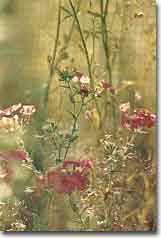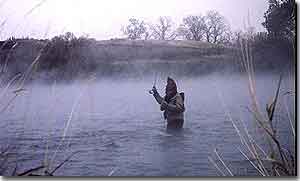Four Seasons on the Bighorn
Four Seasons on the Bighorn
By Bob Krumm
I believe there was a song from the musical, Camelot, that ran somewhat like this: "If ever I were to leave thee, it wouldn't be in springtime, knowing you in springtime I'm bewitched by you so." That could apply to the Bighorn River for any season, but spring is especially so. Spring means a rebirth of the countryside, a time for life to begin anew. Rainbows are spawning, brown trout fry are swimming up from the gravels, migratory birds are arriving, geese are nesting, and pheasants are mating.  Spring means fields of wild flowers. Early arrivals include small, inconspicuous flowers such as Hood's phlox, stork's bill, sagebrush buttercups, Nutall's violets, and biscuit roots. As the season progresses, the flowers become taller and showier, e.g., bluebells, penstemons, wild flax, wild plum, currants, chokecherry, prairie smoke, and fringed paintbrush. Spring means fields of wild flowers. Early arrivals include small, inconspicuous flowers such as Hood's phlox, stork's bill, sagebrush buttercups, Nutall's violets, and biscuit roots. As the season progresses, the flowers become taller and showier, e.g., bluebells, penstemons, wild flax, wild plum, currants, chokecherry, prairie smoke, and fringed paintbrush. The insect hatches never really quit the Bighorn River, even in the middle of the winter you will find midges hatching on the most bitter cold days. As March rolls around and the air temperature warms, the midge hatches begin to grow in numbers. Though the trout feed on the emerging midges, usually only the smaller fish feed on the solitary adult midges. It is not until later in the day that the midges start clustering and the larger trout start feeding on the tiny morsels. Sometimes the clusters can be the size of dimes or, even, nickels; when that happens a springtime feeding frenzy starts. Whenever appreciable midge clusters appear, trout of all sizes will be looking up. The larger trout will congregate at the edge of a feed line and pick off the clusters as they float by. It is not unusual to see twenty to fifty trout ranging in size from 16 to 24 inches working on a feed line. Usually a midge cluster pattern like a Griffith gnat, or a midge cluster will work quite well. Another pattern, the dog pile, that my son, Clint, invented really works. The pattern is simply a size 14 Griffith gnat with four to six dun-colored CDCs tied in trude style. When there are plenty of clusters, Clint will often fish two dog piles about six inches apart. The two fly set up seems to draw more takes and is more visible to the angler. Of course, with the midge emergence there is great nymph fishing as well. Many anglers use midge pupae patterns (size 18 or 20) doing long, dead drifts, but allowing the nymph(s) to swing up at the end of the float. Spring nymph fishing can yield an angler many trout in a day--from 10 to 50 or more--so try to set a catch and release limit of 15 or 20 and call it a day. Maybe, after a good morning's nymph fishing you could relax for awhile, enjoy the spring scenery, then head out for the late afternoon midge cluster event. As spring rolls on, the midge hatches keep getting better, but a larger aquatic insect starts to make an appearance in mid-April. The Baetis mayfly or blue-winged olive starts emerging then. While this small size 16 to 18 mayfly doesn't start appearing in appreciable numbers until late April, the trout seem to feed on the emergers and adults as soon as they start appearing.  The height of the Baetis hatch is mid to late May and is most pronounced on cloudy days. It is on those days that anglers can have the dry fly fishing time of their lives from 11:00 a.m. until 2:00 p.m. or later. There are many patterns that work well for the hatch such as the sparkle dun, blue-winged olive, Baetis cripple, parachute Adams, and blue quill. The height of the Baetis hatch is mid to late May and is most pronounced on cloudy days. It is on those days that anglers can have the dry fly fishing time of their lives from 11:00 a.m. until 2:00 p.m. or later. There are many patterns that work well for the hatch such as the sparkle dun, blue-winged olive, Baetis cripple, parachute Adams, and blue quill. Most anglers use four or five weight rods with 10 to 12 foot leaders tapered to 5X or 6X to fish dry flies on the Bighorn. While two or three weight rods are acceptable, they don't have the power to cast into the wind or subdue a trout quickly. The nymph fishing prior to the Baetis hatch is usually very good. Small gold-ribbed hare's ears in sizes 16 and 18 work well as do similar-sized pheasant tail nymphs, Baetis nymphs, skinny Nelsons, and RS-2s. Make sure to let the nymphs rise up at the bottom of the float! It seems that the trout really like that movement to trigger a strike. The Bighorn River is a tail water fishery. What that should mean to you is that it takes a long time for the 70 mile long reservoir above the river to warm up and cool down. The water temperatures will be 38 degrees until late April or mid May. The temperature may not creep up to 45 degrees until early June. Remember to bring good, capilene type long underwear and neoprene waders. Boot-foot waders are much warmer than stocking foot waders. Simms makes an excellent cold weather-cold water wader, the Exstream which is five mil neoprene coupled with felt boot liners. It makes cold water fishing very comfortable. There are lots of effective nymph patterns that work in the spring time on the Bighorn. Some of the aquatic invertebrates that are common to the Bighorn year round are the sow bugs or cress bugs and the scud. I have found that most any nymph that imitates the sow bug will catch fish year around on the Bighorn. The Bighorn does draw large numbers of anglers in late April through May, so if you can't stand crowds come in mid-March to mid-April or try fishing later in June. Regardless of crowds, I think that whenever you find time to fish the Bighorn, you will find that you certainly won't leave it in the springtime! Good luck and happy angling. Bob Krumm*
|
